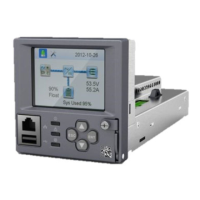Vertiv™ NetSure™ Control Unit (NCU) User Manual
• Signal Active: This selects a TL1 signal to be monitored and processed for TL1 commands and reports. The field has
one of two values - ‘active’ or ‘inactive’. Setting the signal to ‘active’ will enable the signal for monitoring and processing
of the associated alarm signals for TL1 commands and reports.
• Sample Signal: This is the NCU sample signal which is associated to the alarm signal. This signal is used to provide a
present value (<monval>) for the TL1 signal (e.g., voltage or temperature reading). This value is used for TL1 commands
and reports.
• Alarm Signal: This is the alarm signal whose status is being monitored and reported.
• Setting Signal: This is the NCU setting signal which is associated to the alarm signal. This signal is used to provide the
threshold (<thlev>) that has been exceeded to generate the alarm causing the change in state of the TL1 signal. This
value is used for TL1 reports. This field is only used for alarms associated sample signals which are decimal or integer
values (e.g., float, unsigned). It does not apply to signals with enumerated or digital (binary) values.
• Condition Type (20 characters maximum): This is the TL1 text designating the condition corresponding to the alarm.
Valid values for this parameter can contain only alphanumeric characters. TL1 uses specific values for this parameter.
Refer to TA-NWT-001360 Tables 5.1 through 5.4.
• Condition Description (32 characters maximum): This is a detailed text description or instructions relating to the
alarm. Valid values for this parameter can contain only alphanumeric characters. May also be used to describe any
action to be taken as a result of the condition.
• Notification Code: This is the TL1 notification code for the associated alarm. It should mirror the alarm severity.
Values are CR (critical), MJ, (Major), MN (Minor), NA (Non-alarmed), and NR (Non-reporting).
- CR - Critical Alarm
- MJ - Major Alarm
- MN - Minor Alarm
- NA - Not Alarmed
- NR - Not Reported When Event Occurs
• Service Effect Code: This is the TL1 service effect code for this alarm. Values are SA (service affecting) and NSA
(Non-Service Affecting).
- SA = service-affecting condition, immediate action required
- NSA = nonservice-affecting condition, action required
• Monitor Value Format (I or D): This specifies the format of the monitored value (monval). Values are integer (I) and
decimal (D).
• Monitor Type (10 characters maximum): This is the type of parameter being monitored. It should indicate the units of
measurement of the sample signal. This field is only used for sample signals that are decimal or integer values (e.g., float,
unsigned) and does not apply to signals with enumerated or digital (binary) values. Only alpha characters can be
entered for this parameter. TL1 uses specific values for this parameter. Refer to TA-NWT-001360 Table 6.1.
5. Click the Submit button.
6. Repeat these steps for other signals to be added to the AID group and to assign signals to other AID groups.

